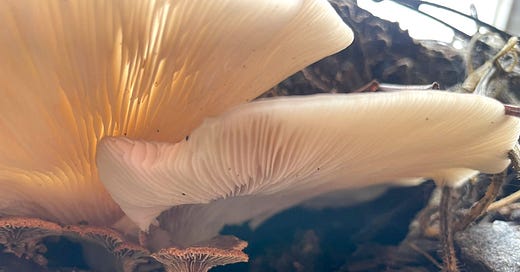Inoculating Salvaged Logs with Oyster Mushrooms - Q&A
Mycelium and Mycoremediation
We recently posted a TikTok about inoculating logs with various forms of fungi in order to remove lead (Pb) and other contaminating heavy metals from Metabolic Studio’s Un-development 1 site in Los Angeles.
We got a lot of great questions in the comments so we wanted to give a more detailed explanation of what we’re doing. Here are some of the questions:
Once (the lead) is in the mushroom, then where does the contaminant go?
If they’re removing hazards, does that make the mushrooms (or fruiting bodies or whatever) a waste product? Are they safe?
Mushrooms can’t convert matter. Heavy metals will still be heavy metals?
Heavy metals taken in by the fungi would then simply be released back into the environment as soon as the fungus decomposes?
Our two sites near Chinatown, Los Angeles, are a former tow-yard and an old Standard Oil warehouse. When we pulled up the tarmac to “un-develop” the sites, we found that contaminants from these industrial uses had been leaching through the tarmac for decades, and remained trapped in the soil below in very high concentrations. We’re currently experimenting with various remediation techniques and have had success using fungi and their mycorrhizal root networks to break down the petrochemical contaminants and capture the heavy metals in the soil.
To address the remains of motor oil, diesel and PAHs (polycyclic aromatic hydrocarbons), we turned to white-rot fungi, a group of fungi that degrade lignin, a polymer making up the structure in wood. White-rot can also metabolize the hydrocarbon rings in most petrochemicals, with the same enzymes it uses to decompose wood. These fungal enzymes break down the strong chemical bonds of the petrochemical molecules into less stable petroleum products that can then be readily decomposed by other microbes, including bacteria and other fungi.
Lead is an issue all across Los Angeles due to the use of leaded gasoline, lead-based paint, lead-acid car batteries, lead pipes/plumbing and waste incineration. Lead is toxic to humans and many non-human creatures if consumed and inhaled, potentially affecting all major systems of the body. Lead and other heavy metals however, are elements and cannot be broken down into smaller component parts, which means ecosystems can’t remove metals without dumping them into another “downstream” environment.
Conventional remediation digs up, transports and then dumps toxic soil on remote sites, hopefully to be treated at some later date. Lead is at its highest risk to human and non-human communities however, when soil is allowed to turn into lifeless, dry dust. It easily travels via wind and water, and is toxic if consumed or inhaled in high quantities. Removing and moving contaminated soil can create toxic dust during excavation and can spread or spill that dust and soil during transportation.
Bioremediation on the other hand sequesters the lead, or bio- or myco-stabilizes and chelates the heavy metals. Chelation is a process that bonds additional atoms to a molecule so it becomes bio-unavailable, preventing heavy metal uptake by an ingesting organism. If ingested, instead of absorbing the toxic metal, the heavy metal passes harmlessly through their system.
Fungi are also adept at gathering and hyperaccumulating certain metals - this is known as myco-accumulation. As the fungi’s below-ground mycelial root networks grow, those networks absorbs materials from the soil. The mycelium draw in and sequester the metals within their root cells or carry the metals to above-ground fruiting bodies, typically known as mushrooms.
At Metabolic we don’t harvest the mushrooms, other than for identification, as we are trying to re-wild our sites. If they do flourish, mushrooms are often first picked over by insects and invertebrates. Many species of these soil-dwelling insects, slugs, snails and roly-polies (woodlice) have developed tolerances to heavy metals and even play a role in bio-remediating lead, as their digestive systems have adapted and can stabilize and chelate heavy metals.
While there is valid concern about the bio-magnification and hyper-accumulation of heavy metals in our local fauna, the animal populations most vulnerable to heavy metal toxicity are actually aquatic. Sequestration keeps heavy metals from washing into the LA River, the Pacific Ocean and other waterways, which is extremely important in building the health and resilience of our watershed.
If mushrooms decompose in an aerobic, healthy soil microbiome, being broken down by other fungi, protozoa, nematodes and bacteria, then the organisms feasting on the fungus continue to sequester and chelate heavy metals. Worms, nematodes and micro-arthropods that ingest this fungus end up chelating the lead again, via their own adaptations. This kind of rich biological environment - in contrast to a barren field with arid conditions - prevents mushrooms from drying up and turning into dust, which would allow the heavy metals to spread once again,
Herein lies one of many arguments to protect, conserve, repair, regenerate and rewild ecosystems. Aside from their own right to exist, we should let ecological systems act as large scale renal and lymphatic systems that sequester, filter, chelate and protect their human and non-human communities from heavy metal and chemical threats to health.
Do you have any questions about mushrooms, fungi, mycelium or bio-remediation? Post them in the comments!








